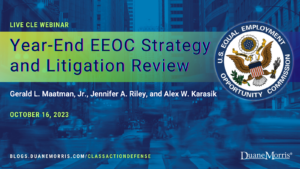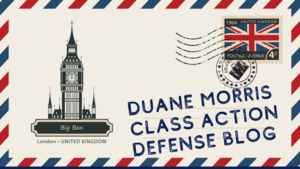Beauty’s Biggest Makeover In 85 Years – MoCRA Delivers Regulatory Overhaul and Class Action Concerns For Cosmetics Companies
Duane Morris Takeaway: This week’s episode of the Class Action Weekly Wire features Duane Morris partner Jerry Maatman and associate Kelly Bonner analyzing a new horizon on the consumer fraud landscape with their discussion of the Modernization of Cosmetics Regulation Act and its looming impact on class action litigation.
Check out today’s episode and subscribe to our show from your preferred podcast platform: Spotify, Amazon Music, Apple Podcasts, Google Podcasts, the Samsung Podcasts app, Podcast Index, Tune In, Listen Notes, iHeartRadio, Deezer, YouTube or our RSS feed.
Episode Transcript
Jerry Maatman: Hello, loyal blog readers and welcome to our weekly installment of our Friday Podcast series called the Class Action Weekly Wire. Today I’m joined by my colleague Kelly Bonner, who is going to talk about some new developments in the cosmetics and fashion world. Welcome, Kelly.
Kelly Bonner: Thanks so much, Jerry. It’s great to be here.
Jerry: One of the areas that you’re a thought leader in is all things cosmetics and fashion. And I understand there’s a new law and regulation that we should be aware of in this space. What’s that all about?
Kelly: Absolutely. Well, thought leader – I’m going to have to tell my mom that one. But yes, the Modernization of Cosmetics Regulation Act, or MoCRA, as it’s colloquially referred to, was passed at the end of last year in December, and it is the most significant expansion of the FDA’s authority to regulate cosmetics since the passage of the Federal Food Drug and Cosmetics Act in 1938. So take a moment to think about it – that’s about 85 years.
MoCRA expands the federal government’s authority over cosmetics and creates significant new obligations for manufacturers, packers, and distributors of cosmetic products intended for sale in the United States. It has been referred to as a sea change, and it is hard to underestimate the impact MoCRA will have on cosmetics sold in the United States.
Until now, cosmetics have been regulated at the federal level under the Food Drug and Cosmetics Act, as well as the Fair Packaging and Labeling Act of 1966. Now with MoCRA, the FDA will be empowered to require facility registration, product listing, reporting of serious adverse events – with an expanded definition of what constitutes a serious adverse event, impose record keeping obligations, enforce mandatory recalls of cosmetic products, and regulations regarding good manufacturing practices.
Jerry: If you’re a corporate counsel, I would imagine that this is going to impact what you do on a day-to-day basis in terms of compliance. Do you have any views for our clients with respect to what they can expect on the compliance front?
Kelly: Yes, Jerry, so since MoCRA’s passage in December 2022, cosmetics companies and personal care companies have been grappling with how to approach MoCRA. MoCRA introduces significant changes for businesses operating in the cosmetics industry. For example, it requires any facility that manufactures or processes cosmetic products intended for sale in the United States to register with the FDA and to list products that are sold. The FDA anticipates that its portal for registration and product listing will go live sometime this month, and they’ve released certain guidance on it. But again, FDA is looking at an avalanche of information.
MoCRA also requires new labeling requirements in products, including providing contact information for serious adverse event reporting; it expands the definition of serious adverse event; it imposes greater record keeping obligations regarding product safety documenting and following up on serious adverse events. These are significant obligations that companies will need to comply with. And a lot of these obligations fall on what MoCRA identifies as a “responsible person.” It’s important to remember that MoCRA’s definition of a responsible person is not the same as a responsible person under EU regulations which were previously in existence and really kind of came up with this idea of what we’re responsible person. So it’s important to be versed in what the law requires, and how it is different from what the EU requires.
Jerry: Sounds to me like in the class action space this is going to create lots of regulations, lots of obligations, lots of duties when it comes to consumer fraud class actions. Do you see this new statute as impacting the class action world?
Kelly: Jerry, yes, this statute is going to impact the class action world. MoCRA, significantly, does not provide federal preemption for state consumer protection or products liability claims. Nor does it alter the existing regulatory framework with the relationship between the FTC – the Federal Trade Commission – and the FDA over what kinds of claims personal care products can make. So already, Jerry, what you’re seeing are plaintiffs bringing class action lawsuits over companies’ usage of terms like “clean,” “natural,” “non-toxic,” under fraud theories, or price premium theories. There may be additional opportunities for plaintiffs to obtain information through MoCRA’s required product ingredient listings and new disclosures that are required under MoCRA. Additionally, the record keeping and adverse event reporting aspect of MoCRA will provide plaintiffs with additional fodder to scrutinize the sufficiency of companies’ safety substantiation data and risk assessment processes to allege that products are not actually “safe” or “non-toxic” or “all natural” or do not contain synthetic ingredients. And so given the continued regulatory ambiguity of what constitutes sufficient safety substantiation, as well as what constitutes natural or clean beauty, companies should expect that their testing and compliance practices and their claims will be scrutinized, particularly in litigation discovery and by plaintiffs’ experts.
Jerry: I had the privilege last week of attending and presenting at a class action conference in London with European and Asian lawyers and in-house counsel, and the talk of the conference was on the emergence of consumer fraud claims throughout Europe and Asia. Do you see this new legislation is contributing to a resurgence of class actions in the consumer fraud area, and especially when it comes to what is known as “forever chemicals”?
Kelly: It’s so interesting that you should mention this, Jerry. Earlier this year I was interviewed by WWD because they wanted to talk about what they saw as a surge in consumer class actions bringing claims involving the beauty space, and they wondered what was really driving that. And you know, I think yes – you are really going to see MoCRA just providing a new ground for plaintiffs to pursue claims like these, particularly when it comes to PFAS. Now, what you refer to as PFAS – or perfluoroalkyl and polyfluoroalkyl substances – a class of chemicals that are sometimes intentionally added in cosmetics and personal care products to make it more spreadable essentially, or sometimes they’re unintentionally present, due to their presence in water that was used to prepare the cosmetic. So one of the key provisions of MoCRA charges the FDA to issue a report by the end of 2025 on the use of PFAS in cosmetics and potential human health effects. So obviously that report is going to be of great interest to the plaintiffs’ bar. Again, MoCRA also doesn’t provide any guidance for companies seeking to avoid class action claims for allegedly false or misleading claims and labeling. And so it really does provide new ground for an aggressive plaintiffs’ bar which will seek to use MoCRA’s obligations, and any perceived non-compliance, as the basis for state law claims.
Jerry: Kelly, thank you so much for your analysis of MoCRA and this new area. I think this is definitely not the last time we’ll be hearing about this issue, and it’ll be on the radar of corporate counsel. So thank you so much for lending your thought leadership today on our weekly podcast.
Kelly: Anytime, Jerry. Thank you so much.
Jerry: Have a great day everyone.











